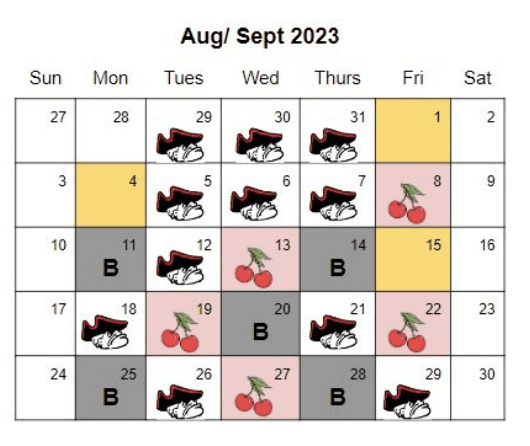As First State public schools reopen next week, most students won’t see much difference in the day-to-day workings of the classroom.
But there’s a lot going on in the background.
Many districts will be adopting new science and math curriculums designed to help counter the state’s dismal test scores – and continue the battle against COVID-19 learning loss.
More mental health programs and people will be in schools, thanks to the multiple pieces of legislation passed in the last few years, including allowing students to take days off for anxiety or behavioral reasons and adding therapists and psychologists to schools.
Schools will be spending the rest of their federal COVID-19 funds, which must be used by the end of September 2024. Those funds can be used for student programs, hiring staff, or virtually all education expenses, but not capital ones.
Teachers and other educators will start being paid more, one arrow in the state’s and districts’ quiver to attract more people to the classroom and keep them there.
And state officials are awaiting a report from a Virginia consultant that will compare the state’s 80-year-old method of funding schools to other states and make recommendations for improvement.
A few students will see changes.
It may be getting to break in a new school, as Appoquinimink students will do with Crystal Run Elementary when it opens Aug. 31.
Colonial’s new schedule
Or it may be something more dramatic, such as William Penn High School students having a new schedule for daily classes.
Colonial Superintendent Jeff Menzer said the district administrations hope that change will improve student success partly by strengthening the relationship between students and teachers.
William Penn will have black, cherry and Colonial days. They are named for the colors in the school’s logo.
The black and cherry days both will allow four classes that are 72 minutes long, standard for many high schools.
Colonial days will contain eight periods, allowing students to see all their classroom teachers for 39 minutes per period.
“Coming off of the pandemic, many teachers and students found that every other day wasn’t great and they really wanted to see their teachers consistently, like every day,” Menzer said.
The first six days of William Penn’s school year, which begins Aug. 29, are going to all be Colonial days, “every period, every day,” Menzer said, “so people get used to that because they’ve never done it.”
Math and science curriculum
The state is in the process of rolling out its new math framework and integrating the science of reading, but the state is unlikely to see big testing gains for years.
The science of reading curriculum is based on brain research that shows how students learn to read, and is focused on phonics – or sounding out letters, syllables, words and sentences.
With nearly half the state unable to meet proficiency scores on tests, educators hope a new reading program, in unison with its 2019 Literacy Plan, will help.
The programs include screening children, early interventions, high quality instructional materials, professional learning for teachers and aligning the reading curriculum to the science of reading.
RELATED: Here’s how science of reading will look in classrooms
Officials have long said that it is critical that students learn to read by the third grade. After that, they need to read to learn and it becomes harder to help them catch up.
“District leaders and everybody realize and recognize that the science of reading actually applies all the way to grade 12,” said Amy Baker-Sheridan, English language arts associate at the Department of Education. “So even without being legislatively required, they have been putting in work to apply the principles of the science of reading into those upper grades.”
For both reading and math programs, teachers have been working with coaches and specialists to understand the curriculum principles and incorporate them into lessons.
Department of Education leaders say that along with improved test scores, creating a culture of confidence and excitement around reading and math is an important metric of success.
Mental health
David Tull, the new executive director of the Delaware School Boards Association, said students gaining access to multiple mental health resources, security and school safety and test scores are his focus for the upcoming year.
One point: Some schools have invested in metal detectors for school door and stadium gates to enhance safety. Trouble at games became a big issue last fall when several schools had incidents.
Student mental health became a focus as kids dealt with high stress during COVID-19 pandemic. In addition, stories of violence and bullying in school were told by parents at school board meetings up and down the state.
SCHOOL SAFETY: Appo to lease weapon detectors amid schools’ focus on safety
Concerns about mental health support have been addressed through recent legislation, including allowing students to take days off to cope, adding mental health education into lessons and hiring more school therapists and behavioral specialists.
MENTAL HEALTH: Student ‘mental health days’ bill among 5 on way to House
MENTAL HEALTH: Bills to add mental health help in schools sent to House floor
MENTAL HEALTH: Bill ordering K-12 mental health curriculum on way to Senate
“If they’re not mentally stable, or don’t have the support they need from a mental health standpoint, how can we expect them to be academically successful?” said Kendall Massett, executive director of the Delaware Charter Schools Network.
Sen. Eric Buckson, R-Dover, who is on the Senate Education Committee, thinks the focus on mental health may have gone too far.
Keeping students out of school for mental health days may not be the answer for some, he said.
They need to confront their anxieties and “grow some calluses,” he said in a June 7 Senate Education Committee meeting.
RELATED: Senator opposes mental health days for students
“We are continuing to add and add and add and that may, in fact, be the problem,” Buckson said this week. “Less might be more, meaning let’s take a breather on more legislation. Let’s review where we are in regards to our current status of learning, which is the key.”
To educate students in reading, writing and arithmetic, they need to be in class, he said.
The state is crowding out basic learning by prioritizing social, emotional and other programs, he said.
“Nothing wrong with them,” Buckson said, “but there’s only so much space inside of a classroom, and our mission is to make sure that our children, in a very basic form, know how to read and write and add and subtract. We’ve really got to take a hard look at what it is that we’re doing.”
Julia Keleher, the new executive director of First State Educate, an education advocacy group, does not agree.
Academic, socio-emotional and environmental supports for teachers and students, especially schools with single-digit proficiency are of importance to her.
RELATED: 17 Del. schools show less than 10% proficiency on state tests
Federal funding
This school year is also the last full year districts have to spend pandemic relief money. The state received more than $600 million in three separate rounds of allocations.
Ralph Ackerman, president of the Delaware School Boards Association and a Brandywine school board member, said he’s looking forward to seeing how districts spend the remaining funds.
Brandywine has used some to purchase curriculum and high quality instructional materials, which he says can get expensive.
High quality instructional materials is one of the elements of the state’s new math framework, which was released at the beginning of 2023.
MATH: State to embrace new math ‘framework’ to raise scores
Only 30.91% of Delaware students are proficient in math (a 1.43% increase from last year), and 40.76% are proficient in English language arts (a 1% decrease from last year), according to the State Report Card.
Utilizing the remaining pandemic relief funds in an effective way will be important to the success of schools this year and moving forward, Ackerman said.
This portal allows the public to see how much COVID relief money is left for each charter school and district.
COVID SPENDING: Here’s how much COVID money districts, charters have spent
State school funding
Keleher is watching Delaware’s budget and potential changes to the funding formula, which has been unchanged since the 1940s.
It was established when school schedules were dominated by agricultural needs, before integration, before the rise of technology, before schools had begun to recognize that some students needed special care and before anyone had connected the dots on how to help those growing up poor or learning disabled.
Delaware has paid the American Institutes for Research $698,438 to analyze current policy and make recommendations for improvements, with a focus on equity for all students.
The report is expected to be released sometime this fall.
FUNDING: State to get advice on improving school funding in fall
FUNDING: Here’s why state wants advice on school funding
Concerns around school funding came to a height after a far-reaching lawsuit resulted in more state funding for poor and special needs children and also triggered a statewide property reassessment.
Many believe the current funding formula is outdated, but nobody agrees on how to fix that.
The funding problems include keeping schools maintained as well as able to support modern needs, such as the explosion of technology.
Students, teachers, board members and other school-based personnel complained throughout the last year that certain buildings are not conducive to a learning environment. Causes include heating and air conditioning units that are inadequate or broken, ceilings that are moldy or drip water and gaps in walls for mice or other critters to get into and more.
RELATED: Red Clay again to seek $289M from state for capital projects
Earlier this month, for example, Red Clay, the largest district in Delaware, again approved a certificate of necessity request for $289 million in state funding.
The district hasn’t been successful in having its request filled by the state for the past 11 years, even though district faculty has said some decade-old schools are not in good shape and need repair.
Teacher pay
With the new school year, the state budget gives educators a 3% raise, with teachers getting an additional 6%, for a total of 9%.
More is on its way.
Fearful that other states who had raised minimum pay for teachers would steal Delaware’s, the state formed the Public Education Compensation Committee last fall to recommend raises to make Delaware competitive.
For example, Maryland passed legislation that will bring starting teacher pay to $60,000 by July 1, 2026.
The committee has discussed the pay of teachers, bus drivers, secretaries, paraprofessionals, nutrition workers, tech employees and more.
RELATED: Heated debate ends in vote to raise teacher pay over 4 years
Final recommendations will be submitted to Gov. John Carney by November and will be sent to the General Assembly.
Not having enough teachers in the classroom and in the education pipeline has meant classes have been combined or people who aren’t qualified to teach them step in
The committee hopes higher pay is one way to solve Delaware’s share of the national teacher shortage.
Some of the major issues with not having an abundance of teachers, substitutes or a steady teacher pipeline include classes being merged; teachers being overwhelmed with the amount of students they have; and administrators and others stepping in to lead a class. Speciality areas like science, math and special education are hit the hardest.
Mark Holodick, secretary of education, said the compensation committee, which he chairs, will switch its focus to working conditions and teacher career ladders. Both contribute to retention, he said.
Throughout the state, teacher residencies and grow-your-own teacher programs that enroll high school students or paraprofessionals have been developed by colleges and school districts. More will come this year, Holodick said.
All of that, education officials hope, ultimately will create a more stable and consistent environment for students to learn.


Raised in Doylestown, Pennsylvania, Jarek earned a B.A. in journalism and a B.A. in political science from Temple University in 2021. After running CNN’s Michael Smerconish’s YouTube channel, Jarek became a reporter for the Bucks County Herald before joining Delaware LIVE News.
Jarek can be reached by email at [email protected] or by phone at (215) 450-9982. Follow him on Twitter @jarekrutz and on LinkedIn
Share this Post










